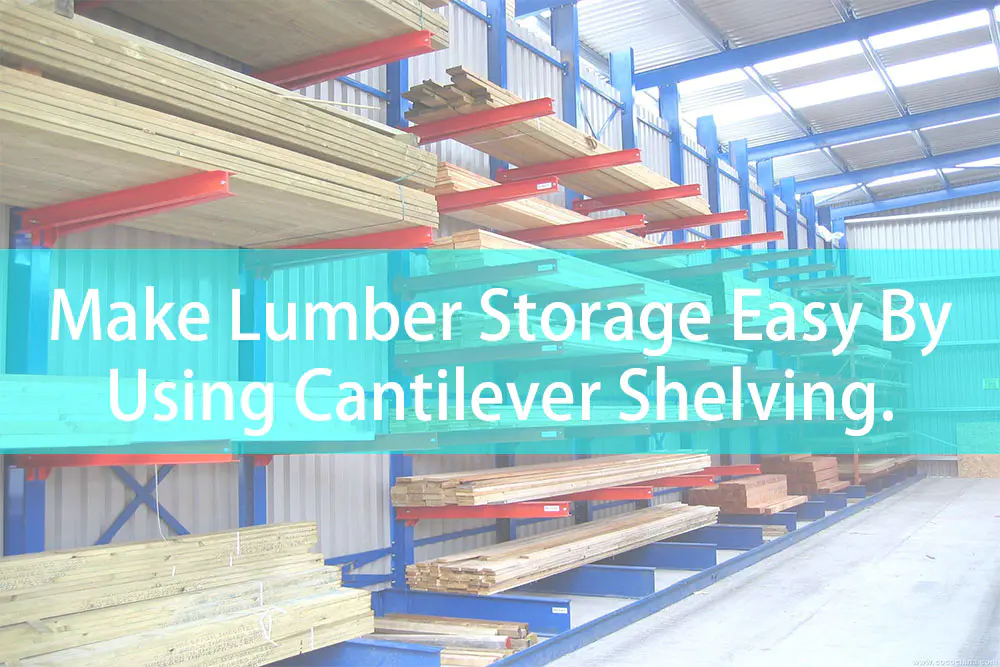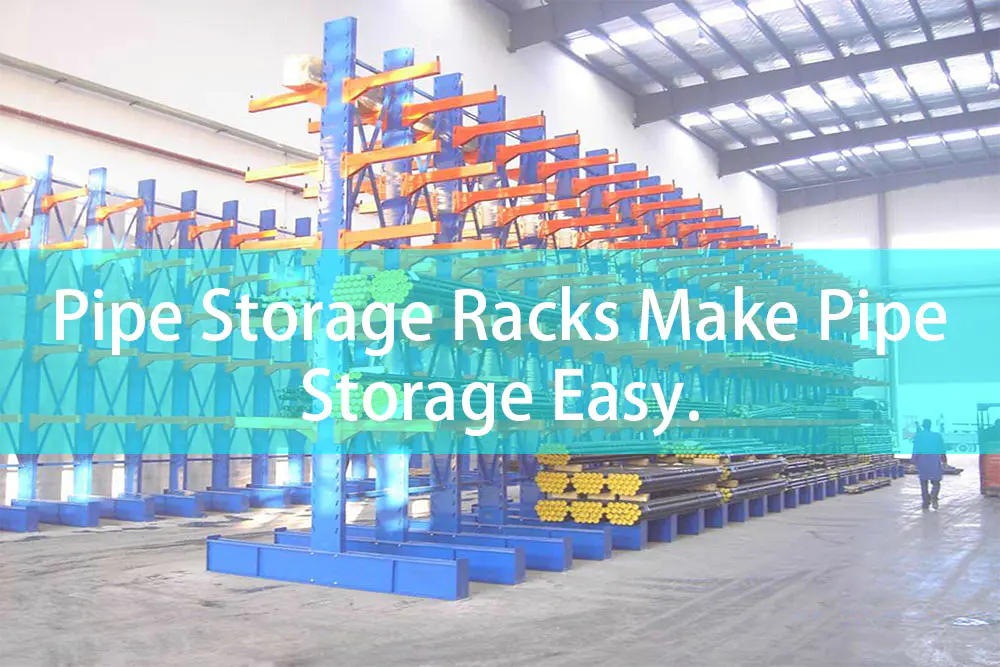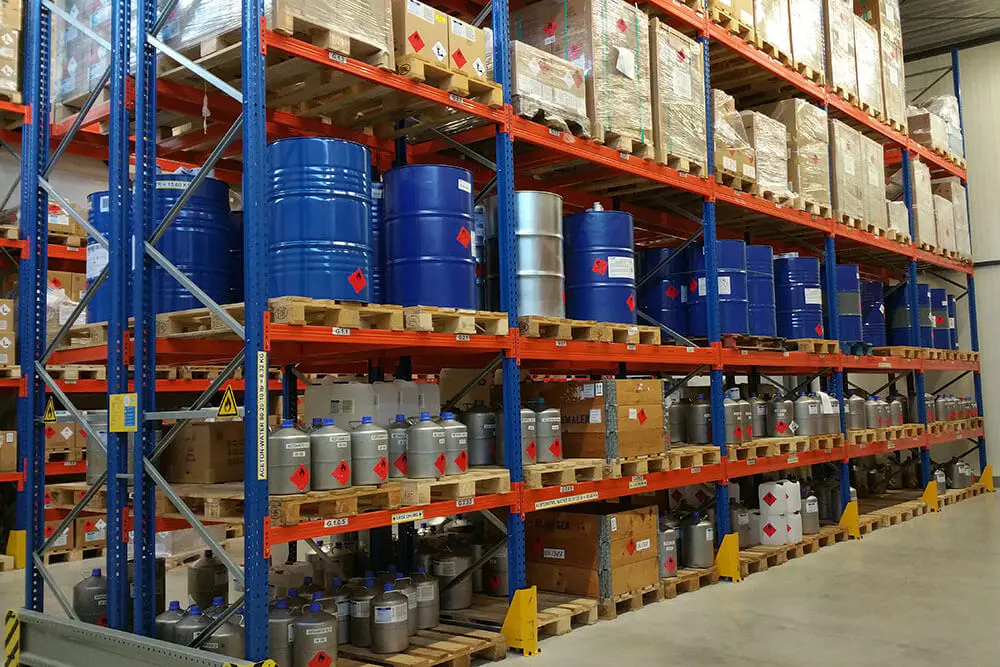by summer
Share

If you are in the lumber business, you know that proper storage is essential to prevent damage to your inventory and keep your warehouse safe. One storage solution that has become increasingly popular in the lumber industry is cantilever shelving.
In this article, we will delve into the specifics of cantilever shelving, including its main components and types. We will also discuss why cantilever shelving is an ideal storage solution for lumber, highlighting its benefits over other storage methods such as pallet racking and so on.
Understanding Cantilever Shelving.
What Is Cantilever Shelving?
In contrast to standard shelving, Cantilever shelving is built to bear the load of these items on horizontal arms that protrude from a central support column. This layout makes better use of available storage space and facilitates quick and simple access to the contents.
When you need to store long, heavy items like lumber, pipes, or steel bars, a cantilever shelf system is the way to go.
Main Components of Cantilever Shelving
A cantilever shelving unit consists of a vertical column, arms, and a base. The system relies heavily on the vertical column, constructed from steel or another strong material. The arms support the storage materials extending outward from the central column. Stability is provided by the system base, which may be either a fixed structure or a mobile one equipped with wheels.
Cantilever shelving systems feature arms that can support a wide range of weights and dimensions. Larger items require longer arms, while smaller items can be handled by shorter arms. When shopping for a cantilever shelf system, it is crucial to consider the load capacity of the arms, as this will define how much weight can be placed on each arm.
A cantilever shelving system also requires bracing. Horizontal or diagonal bracing can provide extra support for the vertical column. Vertical columns can be stabilized and kept from tottering with the help of horizontal bracing, while the integrity of the whole structure can be maintained with the assistance of diagonal bracing.
Types of Cantilever Shelving
There are two main types of cantilever shelving: single-sided and double-sided. Single-sided cantilever shelving has arms that extend from one side of the vertical column, while double-sided cantilever shelving has arms that extend from both sides. Double-sided cantilever shelving is often used in areas where materials need to be accessed from both sides, while single-sided shelving is commonly used against walls.
Why Use Cantilever Shelving for Lumber Storage?
Easy Access: Unlike traditional shelving systems, cantilever shelving allows for easy access to materials from any point along the shelf. This is particularly important for lumber storage, as it allows workers to quickly and easily retrieve the specific piece of lumber they need without having to sift through a stack of boards.
Space Efficiency: Cantilever shelving is more space-efficient since it can be adjusted to meet the items’ dimensions. Cantilever shelving’s vertical form also eliminates the need for supplemental shelves, so you can store items at varying heights.
Flexibility: Making the most of the available space, the arms of the shelf unit may be adjusted to store items of varied lengths. The height and number of shelves on the shelving unit may be adjusted, and the arms can be added or removed to accommodate a variety of storage needs. The system’s flexibility means it may be altered to accommodate emerging data storage needs.
Safety: Injury from inappropriate stacking or overloading is reduced because of the shelf system’s horizontal arms, which distribute the weight of the stored goods evenly. The shelving unit’s solid build also makes it less likely that it will topple over, protecting both people and items from harm.
Durability: Cantilever shelving is made from strong materials like steel so that it can support a lot of weight. The heavy goods may be stored safely and securely on the shelves because of their durability.
Organization: The vertical layout of the shelving system makes it possible to store items without the mess and confusion that characterizes more conventional approaches to timber storage. This neat appearance can boost productivity by making it simpler to find what workers need.
Cost-Effective: Cantilever shelving can be an economical choice for lumber storage since it makes better use of available space and protects stored goods from being scratched or dented.
Customization: It is possible to modify cantilever shelving to meet the unique requirements of any company or institution. The number of arms, their distance from one another, and the system’s height, width, and depth are all modifiable.
Accessibility: Cantilever shelving is more comfortable for workers since it facilitates quick and easy material retrieval. The time it takes to search for and obtain needed information can be cut down if it is easily accessible to all employees.
Comparison Between Cantilever Shelving and Other Forms of Storage for Lumber.
Pallet Racking
This method involves using horizontal beams supported by vertical frames to create levels of storage space. Each level can hold pallets of lumber, which can be accessed using a forklift or other material-handling equipment.
Pallet racking is a practical method of warehousing lumber. The wooden pallets are put atop the already-erected vertical frames. The pallets are subsequently secured in place, either using straps or another method. Forklifts and other forms of material handling equipment may then quickly and easily access the lumber pallets.
When it comes to maximizing vertical storage density, nothing beats pallet racking for timber. Thanks to its vertical storage capacity, pallet racking is a great option for businesses with limited floor space since it allows for the storage of a large quantity of lumber in a relatively small area. Pallet racking is a long-lasting storage option that can support even the heaviest of timber loads.
Another advantage of pallet racking is the ease with which lumber can be organized and located. Pallets of lumber may be easily accessed by forklifts or other material handling equipment, and the timber can be easily organized by size, type, and other criteria, thanks to the storage levels.
While pallet racking is an easy way to store lumber, it does come with a few limitations. A pallet racking system’s initial investment and ongoing upkeep may be challenging for certain businesses. If a company wants to employ pallet racking for lumber storage, it may need to invest in additional infrastructure, such as material handling equipment.
Pallet racking may not be the greatest choice for firms that deal with a wide variety of lumber sizes and forms, which is another possible downside. Some types of wood may not be appropriate for storage on pallet racking because it is meant to handle standardized pallets.
Block Stacking
The term “block stacking” refers to the old method of storing timber, which includes piling boards directly on top of one another without the aid of shelves or other storage devices. This is common in vast, open warehouses and other outdoor storage areas.
Stacking wood blocks is a quick and efficient way to organize your timber. Lumber can be organized according to size, type, or other variables before being vertically stacked into blocks. To keep them from tipping over easily, be sure to stack wood evenly. Once done, you can secure the blocks with straps or other methods in order to prevent dismantling.
Block stacking offers several distinct advantages when it comes to lumber storage. Businesses may store significant amounts in a relatively compact footprint without spending on shelves or support systems for additional support systems.
Block stacking offers many advantages over other methods for storing lumber, but it does come with some drawbacks. One issue related to block stacking involves extracting individual wood planks from their storage block. Workers may have to take several layers of lumber off before reaching their piece – making this method time-consuming and potentially dangerous for workers.
Also, unevenly-stacked and improperly secured blocks may damage lumber and cause employee injuries. Finally, it should not be used when stacking large pieces of lumber as this takes up too much space.
Wall-Mounted Storage
Wall-mounted storage solutions are an increasingly popular method for storing tools, supplies, and lumber in limited floor spaces. Wall-mounted units often consist of brackets or supports mounted to the wall with shelves or hooks installed atop to hold lumber securely.
Wall-mounted storage solutions offer many advantages for space-saving purposes, including their capacity to make the most efficient use of wall space and keep floor areas free for other tasks and activities. Furthermore, this option is often more cost-effective than larger solutions like pallet racking.
But wall-mounted storage does have its drawbacks, such as weight limitations. They have a limited weight limit, limiting how much lumber can be stored on them at once. Furthermore, longer or larger pieces may protrude and become hazardous when stored wall-mounted.
Wall-mounted storage can also be limited by its fixed nature. Once brackets or supports have been mounted on the wall, adjusting or moving shelves or hooks becomes more challenging. This could become problematic as storage needs shift over time or workspace changes are necessary.
Which Type of Storage is Ideal for Lumber Storage?
While these are all good options for storing lumber, cantilever shelving stands out as the superior lumber storage solution due to its versatility, accessibility, and capacity. It provides easy access to lumber of various sizes, shapes, and weights – perfect for long or irregularly-shaped pieces that would not fit in other storage systems.
Cantilever shelving is adjustable, enabling users to tailor it precisely to their storage needs and maximize available space. Plus, cantilever shelving provides greater organization by increasing capacity than alternative solutions – making cantilever shelving one of the most cost-efficient ways of keeping lumber accessible, organized, and safe!
Installing Cantilever Shelves for Lumber Storage.
We recommend installing your cantilever storage through a professional. But if in case you are a DIY enthusiast, here is a step-by-step process to installing a cantilever shelving system.
Prepare Your Space
Before installing cantilever shelving, ensure the area where it will be placed is free from debris or obstruction. Likewise, ensure the floor is level and walls can support its weight as well.
Assemble Shelving
Begin assembling your shelving according to its manufacturer’s instructions; be careful and take care not to make any errors in assembly. If any steps seem confusing or you need additional guidance or professional help, refer back to the instructions or seek professional assistance immediately.
Select Appropriate Hardware
When it comes to installing cantilever shelving, choosing the appropriate hardware is absolutely critical. Make sure that when choosing hardware for your cantilever shelves, you take into account both their weight capacity and any materials being stored on them – choosing hardware that best accommodates these factors is of utmost importance!
Assemble the Base
Now is the time to assemble the base. To assemble the base of your shelving system, start by connecting uprights to base plates and anchor bolts anchored into the floor using anchor bolts. Ensure all uprights are vertical and plumb by using a level to check.
Install Arms of Shelving
After setting up the base, proceed with installing the arms of the shelving. These are horizontal beams that extend from uprights and hold lumber. Be sure to attach these securely so they are level and at an ideal distance apart.
Install Braces
The purpose of braces is to connect arms and uprights together and add stability to shelving systems. Install them at regular intervals and at an angle appropriate to their purpose.
Load Your Shelving
Once your shelving system has been assembled, the next step should be loading it up with lumber. Be sure to spread the weight evenly among its arms to avoid overloading any one section, and store lumber securely to avoid falling or tipping over.
Maintenance
Regular maintenance should be conducted to inspect it for any damages for optimal cantilever shelving performance and safety. Additionally, recheck everything again. This may involve inspecting for damages to inspect for, tightening any loose hardware, and cleaning your shelves when necessary.
Tips for Cantilever Shelving for Lumber Storage.
Keep it Flat
The best way to keep wood straight and flat is simply by storing it straight and flat. It is important to store lumber in piles rather than as individual boards to keep the temperature, humidity, and airflow equal on both sides of each board. Leaning a board against a wall or laying it flat on a table or the floor exposes each side of the board to different conditions, which can cause twisting, bowing, and cupping.
Keep it Dry
Wood and water are not best friends, so it is important to keep dry lumber away from water. Store your dry lumber in a place where it won’t get wet, such as on shelves where there are no roof leaks or directly off the floor with skids. Avoid storing dry lumber outdoors, but if you must, use stickers between each course of lumber to help it dry. A lean-to can also help keep rain and snow off the lumber and increase the drying rate.
Keep it in Your Shop
Storing your lumber in your shop can prevent it from moving after you cut into it, as it will acclimate to the shop conditions for a week before machining it. This means you do not have to let it sit around and acclimate when you’re ready to start a project, and it doesn’t sacrifice quality. If you must store your lumber outside of your shop, consider storing it in your basement, as most basements have a relatively dry environment for most of the year.
Keep it Organized
The organization is vital to finding your lumber when you need it. Organize your lumber based on specie, thickness, and possibly even length. This can save you time and hassle down the road.
Conclusion
Cantilever shelving has become an increasingly popular storage solution due to its efficiency, accessibility, flexibility, safety, durability, organization, cost-effectiveness, customization, and accessibility. Its design allows easy access to materials, efficient use of storage space, and the flexibility to adapt to changing storage needs over time. Although there are other storage options, they may not be the best solution for lumber storage, as they do not provide the same level of accessibility and organization that cantilever shelving does.
Equipment that is used to move, store, distribution, co […]
The construction and manufacturing industries are the l […]
If you are a fabric store owner, a quilter, or a sewing […]




